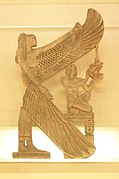Petubastis IV. Seheribre
| Name of Petubastis IV. Seheribre | ||||||||||||||||
|---|---|---|---|---|---|---|---|---|---|---|---|---|---|---|---|---|
| Throne name |
S.hrw-jb-Rˁ Who delights / satisfies the heart of Re |
|||||||||||||||
| Proper name |
(Pa di Bastet) P3 dj B3stt The one that Bastet gave |
|||||||||||||||
Petubastis IV. Seheribre (also Padibastet IV. ) Was a late Egyptian prince and anti -king ( pharaoh ) to the Persian great king and Egyptian king Cambyses II at the beginning of the first Persian rule , the 27th dynasty.
Nothing is known about the origin of the king. It is certain that he acted during the 27th Dynasty. A connection to the string kings of the 26th dynasty is conceivable, but not proven.
The king is only attested on a few monuments: These are fragments of a wooden naos with lost colored glass inlays (today in Bologna and in the Louvre ), a scarab , two seal impressions (one today in the Los Angeles County Museum of Art , M.80.202.852) and a temple portal in Amḥeida , ancient Egyptian: Set-waḥ , Greek: Trimithis , in the Dachla valley . On these monuments the prince was named with the title of an Egyptian king.
The French Egyptologist Jean Yoyotte was able to trace the reign of Petubastis IV. Seheribre to 522-520 BC. To establish. He was involved in a revolt against the Persian satrap Aryandes , who was still used under Cambyses II. This revolt was handed down in the strategemata of Polyainus . The period mentioned extends from the death of Cambyses II to the renewed securing of rule under the Persian great king Dareios I.
The Dutch Egyptologist Olaf E. Kaper suggested on the basis of the temple portal find of Amheida that Petubastis IV. Seheribre had a base here and that he could have defeated Cambyses II's army from here. This would be in contrast to the second-hand tradition of Herodotus , according to which the army perished in a sandstorm on its campaign against the oracle of Siwa . Kaper postulated that Cambyses II's target was the Dachla valley and not Siwa . One of the most important arguments is that Siwa is usually reached from Memphis , not from Thebes , and that it would not have taken 50,000 soldiers to conquer Siwa.
literature
- Labib Habachi : Three Monuments of the Unknown King Sehetepibre Pedubastis . In: Journal of Egyptian Language and Antiquity . tape 93 , 1966, ISSN 0044-216X , p. 69–74, two plates (Habachi quotes Jean Yoyotte on pages 73 f., Note 25 f.).
- Jean Yoyotte: Pétoubastis III . In: Revue d'Égyptologie . tape 24 , 1972, ISSN 0035-1849 , p. 216–223, plate 19 .
- Jürgen von Beckerath : Contributions to the history of the Libyan period; 3. The kings named Pedubaste . In: Göttinger Miscellen : Contributions to the Egyptological Discussion (GM) . tape 147 , 1995, ISSN 0344-385X , p. 9-13 .
- Thomas Schneider : Lexicon of the Pharaohs . Deutscher Taschenbuch-Verlag, Munich 1996, ISBN 978-3-423-03365-7 , pp. 291 .
References and comments
- ↑ The numbering is different: Kenneth Anderson Kitchen and Jean Yoyotte call him Petubastis III. (Kenneth Anderson Kitchen: The Third intermediate period in Egypt: 1100-650 BC Aris & Phillips, Warminster 1973, ISBN 978-0-85668-298-8 , § 78.), Jürgen von Beckerath Petubastis IV. (In: Chronologie des Pharaonic Egypt (= Munich Egyptological studies. [MÄS] No. 46). von Zabern, Mainz 1997, ISBN 3-8053-2310-7 .)
- ^ Henri Gauthier : Le livre des rois d'Égypte; Vol. 3: De la XIXe à la XXIVe dynasty . Imprimerie de l'Institut Francais d'Archeologie Orientale, Paris, Le Caire 1914, p. 397 .
- ^ A b Olaf E. Kaper: Policies of Darius I in the Western Desert of Egypt . Political Memory during and after the Persian Empire ( Memento from March 11, 2015 in the Internet Archive ), International Conference of the ERC project BABYLON, June 19, 2014.
- ^ Leiden Egyptologist unravels ancient mystery , message from the University of Leiden, June 19, 2014, accessed on June 28, 2014.
- ↑ Jürgen von Beckerath : Handbook of the Egyptian king names (= Munich Egyptological studies. Vol. 49 ). 2nd, improved and enlarged edition. von Zabern, Mainz 1999, ISBN 978-3-8053-2591-2 , p. 222-223 .
- ↑ Polyainos, Strategemata , Book 7, Chapter 11, § 7 .
- ↑ Herodotus , Historien , 3rd book, §§ 17, 25-26.
Web links
| personal data | |
|---|---|
| SURNAME | Petubastis IV. Seheribre |
| BRIEF DESCRIPTION | late Egyptian prince |
| DATE OF BIRTH | 6th century BC Chr. |
| DATE OF DEATH | 6th century BC BC or 5th century BC Chr. |


